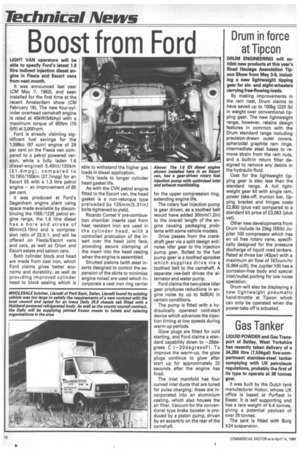Boost from Ford
Page 18

If you've noticed an error in this article please click here to report it so we can fix it.
UGHT VAN operators will be able to specify Ford's latest 1.6 litre indirect injection diesel engine in Fiesta and Escort vans from next month.
It was announced last year (CM May 7, 1983), and seen installed for the first time at the recent Amsterdam show (CM February 18). The new four-cylinder overhead camshaft engine is rated at 40kW(54bhp) with a maximum torque of 95Nm (70 lbft) at 3,000rpm.
Ford is already claiming significant fuel savings for the 1,598cc (97 cuin) engine of 29 per cent on the Fiesta van compared to a petrol powered version, while a fully laden 1.6 diesel-engined 5.491it/100km (5 1.4mpg), compared to 10.191it/100km (27.7mpg) for an Escort 55 with a 1.3 litre petrol engine — an improvement of 85 per cent.
It was produced at Ford's Dagenham engine plant using space made available by discontinuing the 105E/122E petrol engine range, the 1.6 litre diesel has a bore and stroke of 80mm(3.15in) and a compression ratio of 22.5:1, and will be offered on Fiesta/Escort vans and cars, as well as Orion and Escort estate and saloon cars.
Both cylinder block and head are made from cast iron, which Ford claims gives better economy and durability, as well as providing improved cylinder head to block sealing which is able to withstand the higher gas loads in diesel application.
This leads to longer cylinder head gasket life.
As with the CVH petrol engine fitted to the Escort van, the head gasket is a non-retorque type preloaded by 135mm(5.31in) bolts tightened to yield.
Ricardo Comet V pre-combustion chamber inserts cast from heat resistant iron are used in the cylinder head, with a controlled protrusion of the insert over the head joint face, providing secure clamping of the insert into the head casting when the engine is assembled.
Strutted pistons (with steel inserts designed to control the expansion of the skirts to minimise engine noise) are used which incorporate a cast iron ring carrier for the upper compression ring, extending engine life.
The rotary fuel injection pump is gear driven, as a toothed belt would have added 30mm(1.2in) to the overall length of the engine causing packaging problems with some vehicle models.
Drive passes from the crankshaft gear via a split design antinoise idler gear to the injection pump gear. Bolted to the fuel pump gear is a toothed sprocket which supplies drive via a toothed belt to the camshaft. A separate vee-belt drives the alternator and water pump.
Ford claims the two-piece idler gear produces reductions in engine noise by up to 6dB(A) in certain conditions.
The pump is fitted with a hydraulically operated cold-start device which advances the injection timing at low speeds during warm up periods.
Glow plugs are fitted for cold starting, and Ford claims a standard capability down to —29degrees C (-20degreesF). To improve the warm-up, the glow plugs continue to glow after start up for approximately 22 seconds after the engine has fired.
The inlet manifold has four curved inlet ducts that are tuned for pulse charging; these are incorporated into an aluminium casting, which also houses the air filter. Vacuum for the conventional type brake booster is produced by a piston pump, driven by an eccentric on the rear of the camshaft.




























































































